Select units of measurement for the temperature and rainfall tables (metric or imperial).
Average weather, temperature, rainfall, sunshine
The climate of Greece, a country in south-eastern Europe, is
Mediterranean on coasts and islands, with mild, rainy winters and hot, sunny summers.
The northern cities, located in the inland areas of Epirus, Macedonia and Thessaly, have a
slightly continental climate, with quite cold winters, during which air masses coming from the north can sometimes bring snow and frost, and hot summers, sometimes scorching.
Finally, in the northern
mountainous areas, winters are cold and snowy, while summers are mild, with possible afternoon thunderstorms.
The climate in detail
The seasons
On coasts and islands of central and southern Greece, where the climate is Mediterranean,
winter is mild and quite rainy. The rains are more abundant on the coasts exposed to the west, on the
Ionian islands and on the islands close to Turkey (
Dodecanese).
In winter,
temperatures in Greece progressively decrease as you head north: the average daily temperature in January is 12.5 °C (54.5 °F) in Iraklion (on the southern island of Crete), 10 °C (50 °F) in Athens, and 5.5 °C (42 °F) in Thessaloniki.
Sometimes Greece is affected by
cold air masses from Northern Europe or Russia: in these cases, the temperature drops remarkably even in mild areas, and
snow can occur in the northern plains (see Thessaloniki), and sometimes even in the central ones. In Athens, which generally has mild winters, during these short periods the weather becomes cold and rainy, and during the most intense cold waves it can even snow.
On the
islands, during winter the
wind often blows; precipitation often occurs at night and in the early morning. On the islands, snowfalls are rare, and generally occur only in the northern ones (
Samothrace and
Thasos in the Sea of Thrace, and sometimes also in the
Sporades and in Euboea), but during the most intense cold spells it can snow even in the
Cyclades Islands.
Spring is pleasant and sunny in most of Greece. The days with some rainfall become less and less frequent. However, by the month of May, in northern areas and in the mountain ranges, thunderstorms can erupt in afternoon.
In addition, in the Aegean Sea, a wind that blows from the north or north-east, called
Meltemi, begins to blow on sunny days in May, and continues especially during summer (see below).

Summer in Greece is hot and sunny. Although the country is not protected by the Azores High, the weather is consistently sunny.
Only in the north and in mountainous areas, where the sun usually shines anyway, at times there can be showers and
thunderstorms in the afternoon, especially in June (in July and August they become a bit rarer). Of course, in mountainous areas, the temperature decreases with altitude, especially at night.
While on the islands and along the coasts the heat is tempered by sea breezes, in the continent, especially in inland areas and in the largest cities, there is
intense heat.
In summer, in the Aegean Sea (especially in the Cyclades) the
Meltemi (or Etesian), a northerly wind typical of the warmest months (July and August), often blows, and even if the sky is clear, it can make the sea dangerous.
This wind can blow for periods of two to four days, but sometimes even for weeks. The Meltemi is caused by the difference in atmospheric pressure between the western part of the Mediterranean, where the Azores High dwells in summer, and the eastern part, which is affected by a low-pressure area that forms because the Iranian plateau and the deserts of the Middle East heat up a lot. For this reason, these winds can not be considered as mere breezes, and can be persistent and annoying.
Autumn in Greece comes quite late; in fact, in September, summer-like weather still prevails, especially in the south and on the islands. The temperature remains mild even in November (except in mountainous areas), however, by October,
rainy periods begin to occur, and at the same time the Meltemi ceases to blow.
The north
In plains and valleys of the north (see Thessaloniki, Larissa), where the climate is more continental, winter is a bit cold, while precipitation is not abundant.
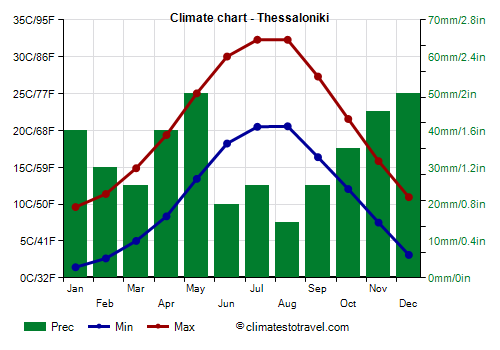
In
Thessaloniki, the average temperature ranges from 5.5 °C in January to 26.5 °C in July and August. The coldest record is -12.5 °C (9.5 °F) and was set in January 1968.
Summer is hot: in July and August, the average maximum temperature is 32 °C (90 °F), but on hotter periods it can easily rise to around 35/36 °C (95/97 °F). The highest record in Thessaloniki is 44 °C (111.2 °F) and was set in July 2007.
Rainfall, which as mentioned is not abundant, has a maximum in late autumn and spring, and a minimum in summer, when rare thunderstorms occur.
The amount of sunshine is very good in summer, when clear skies prevail, while in autumn and winter it's not high, since there are several cloudy periods.
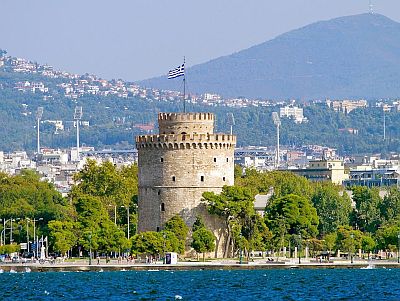
In
inland and mountainous areas, winter is cold, especially in the far north, on the border with Macedonia and Bulgaria, where there can be cold waves with heavy snowfalls and intense frosts.
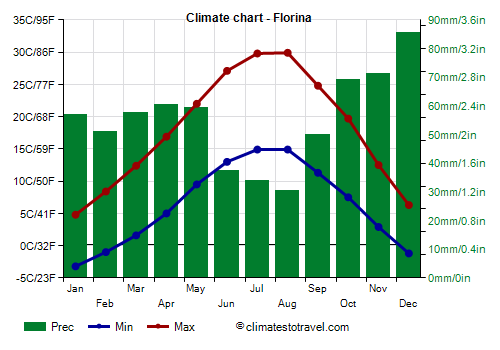
In
Florina, located in the extreme north, on the border with North Macedonia, at 650 meters (2,100 feet) above sea level, the average temperature in January is 1 °C (34 °F). In a normal year, there is an average of 27 days with snowfall. During cold waves the temperature can drop to -20 ° C (-4 °F).
Summer is hot during the day (sometimes very hot), but nights usually remain cool.
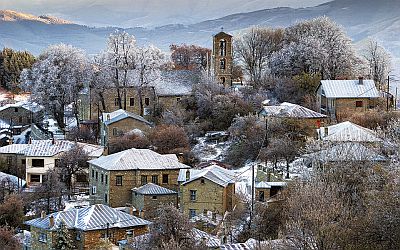
On Mount
Olympus, the highest mountain in Greece with its 2,917 meters (9,570 feet), it is possible to do cross country skiing.
In the Peloponnese, the large peninsula connected to the mainland by the isthmus of Corinth, the highest peak is Mount
Taygetos, 2,404 meters (7,887 feet) high.
Even on the northernmost islands (Samothrace and Thasos in the Sea of Thrace, but also
Skiathos and
Skopelos in the Sporades), winter is quite cold, and sometimes it can snow.
Center-south
In central-southern Greece, there is a
Mediterranean climate, with mild, fairly rainy winters and hot, sunny summers.
However, the central areas (see Athens, Patras, Corinth) are still quite exposed to cold waves, so they can sometimes experience cold periods, and even snowfall.
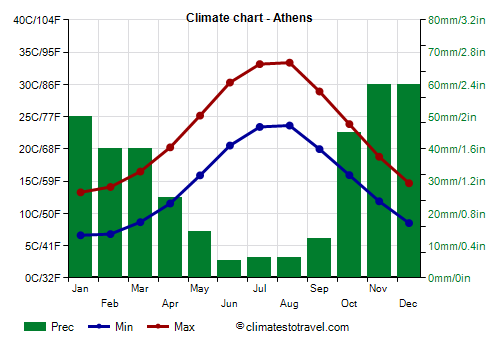
In
Athens, the average temperature ranges from 10 °C (50 °F) in January to 28.5 °C (83.5 °F) in August. Though it overlooks the sea, in summer, Athens is the hottest capital in Europe. Maximum temperatures of 36/38 °C (97/100 °F) are not rare. In addition, it should be recalled that it is a polluted city, often wrapped in a blanket of smog.
In Athens, the rains are quite scarce, and mostly fall from October to April.
The amount of sunshine in Athens is great in summer, when clear skies prevail, while it's not so high from November to February, although there may be sunny days even in midwinter.
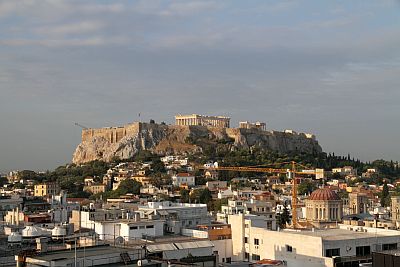
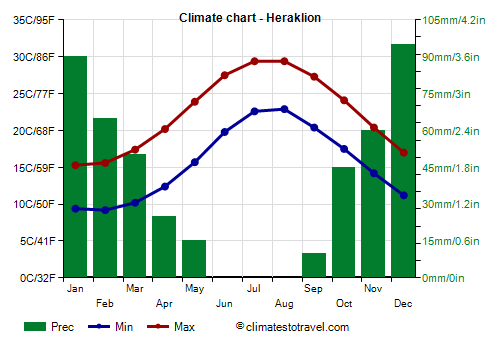
In
southern Greece (see the Dodecanese,
Crete,
Kythera, and also the southernmost islands of the Cyclades and of the Ionian Islands), winter is even milder, and cold spells are less intense, even though there may be windy and somewhat cold days. Summer is hot and sunny, but it is not as hot as in Athens because the influence of the sea is felt more. However, the temperature can increase when hot air masses arrive from Africa.
On the southern coasts and the islands, the rains experience a maximum in winter and a noticeable minimum in summer, when it almost never rains.
Sea temperature
In the central part of the Aegean Sea (see
Naxos,
Mykonos), the temperature of the
sea never becomes very warm because the prevailing wind, the Meltemi, prevents it from warming up, by mixing the upper layers of the water. However, it reaches 24 °C (75 °F) in August.
In the southern part of the Aegean Sea (see Crete) and in the Ionian Sea (see Corfu), the sea temperature in summer is a little higher, and it's warm enough for swimming from July to September. In Heraklion (Crete), the sea temperature reaches 25 °C (77 °F) in August.
When to go
To know when is the best time to visit Greece, it is necessary to distinguish according to the purpose of the trip:
- The best period for a
beach holiday is the long summer, from early June to mid-September. In this period, there are no clouds in the sky for long periods, the heat is at times intense, but on coasts and islands it is tempered by the breeze. In the Aegean Sea, the
Meltemi often blows.
- The best seasons for visiting
historic and archaeological sites and cities are spring and autumn. Summer is often too hot, especially in the mainland, and in July and August. However, June and September can be hot as well, with average highs around 28/30 °C (82/86 °F) in the capital.
Winter is cold in the north and in the mountainous regions, while it is windy and rainy in the south and on the islands, so it's is not the best season to visit Greece. On the other hand, in this period, given the low amount of tourists, you can go on excursions and visit historic and archaeological sites, with greater tranquility and solitude.
In general, the best times are the month of
May, and the period from mid-September to mid-October; the former offers longer days and the nature in bloom, while the latter offers a warmer sea, which can be a possibility in the pauses between excursions.
In October, temperatures are pleasantly warm and resemble those of May, but the days are shorter, and sometimes it rains, especially in the second half of the month.
In November, the sky is often cloudy and the rains are frequent, even though it's generally not cold.
In April, the weather is often mild and sunny, though some disturbances may still pass, so all in all a trip to Greece may be advisable even in this month.
What to pack
In
winter: in inland and mountainous areas: bring warm clothes, such as a down jacket, a hat, gloves, a scarf. In Athens and in central and northern coastal areas: bring warm clothes, such as a sweater, a jacket, a raincoat or umbrella. In Crete and on the southern islands: clothes for spring and autumn, a sweater, a jacket, a raincoat or umbrella.
In
summer: bring light clothing, sunglasses, sunscreen, a light scarf and a sweatshirt for the evening, especially on the islands of the Aegean Sea, where the Meltemi blows. In the mountains, you can bring a sweater, a jacket, hiking shoes, a raincoat or umbrella.
See also the climate of the
Greek Islands.
Climate data - Greece
| Athens |
|---|
|
| Jan | Feb | Mar | Apr | May | Jun | Jul | Aug | Sep | Oct | Nov | Dec |
|---|
| Min temp. | 7 | 7 | 9 | 12 | 16 | 21 | 23 | 24 | 20 | 16 | 12 | 8 |
|---|
| Max temp. | 13 | 14 | 16 | 20 | 25 | 30 | 33 | 33 | 29 | 24 | 19 | 15 |
|---|
| Precip. | 50 | 40 | 40 | 25 | 15 | 5 | 5 | 5 | 10 | 45 | 60 | 60 |
|---|
| Prec. days | 9 | 7 | 8 | 6 | 4 | 1 | 1 | 1 | 3 | 5 | 8 | 11 |
|---|
| Humidity | 69% | 67% | 65% | 60% | 58% | 52% | 46% | 46% | 54% | 63% | 69% | 70% |
|---|
| Day length | 10 | 11 | 12 | 13 | 14 | 15 | 14 | 14 | 12 | 11 | 10 | 10 |
|---|
| Sun hours | 4 | 5 | 6 | 8 | 9 | 11 | 12 | 11 | 9 | 7 | 5 | 4 |
|---|
| Sea temp | 16 | 15 | 15 | 16 | 18 | 22 | 24 | 25 | 24 | 22 | 19 | 17 |
|---|
| Corfu |
|---|
|
| Jan | Feb | Mar | Apr | May | Jun | Jul | Aug | Sep | Oct | Nov | Dec |
|---|
| Min temp. | 5 | 6 | 8 | 10 | 14 | 18 | 20 | 21 | 18 | 14 | 10 | 7 |
|---|
| Max temp. | 14 | 14 | 17 | 20 | 25 | 29 | 32 | 33 | 28 | 24 | 19 | 15 |
|---|
| Precip. | 115 | 85 | 80 | 75 | 30 | 15 | 15 | 30 | 85 | 110 | 175 | 195 |
|---|
| Prec. days | 8 | 8 | 7 | 8 | 4 | 2 | 1 | 2 | 5 | 7 | 10 | 12 |
|---|
| Humidity | 78% | 75% | 75% | 73% | 71% | 67% | 63% | 64% | 72% | 77% | 79% | 79% |
|---|
| Day length | 10 | 11 | 12 | 13 | 14 | 15 | 15 | 14 | 12 | 11 | 10 | 9 |
|---|
| Sun hours | 4 | 5 | 6 | 8 | 10 | 11 | 12 | 12 | 10 | 7 | 5 | 4 |
|---|
| Sea temp | 15 | 15 | 15 | 16 | 19 | 22 | 25 | 26 | 24 | 22 | 19 | 17 |
|---|
| Florina (650 meters) |
|---|
|
| Jan | Feb | Mar | Apr | May | Jun | Jul | Aug | Sep | Oct | Nov | Dec |
|---|
| Min temp. | -3 | -1 | 2 | 5 | 10 | 13 | 15 | 15 | 11 | 8 | 3 | -1 |
|---|
| Max temp. | 5 | 8 | 12 | 17 | 22 | 27 | 30 | 30 | 25 | 20 | 12 | 6 |
|---|
| Precip. | 55 | 50 | 60 | 60 | 60 | 35 | 35 | 30 | 50 | 70 | 70 | 85 |
|---|
| Prec. days | 11 | 11 | 11 | 11 | 11 | 7 | 6 | 5 | 6 | 8 | 10 | 12 |
|---|
|
|
|
|
| Heraklion |
|---|
|
| Jan | Feb | Mar | Apr | May | Jun | Jul | Aug | Sep | Oct | Nov | Dec |
|---|
| Min temp. | 9 | 9 | 10 | 12 | 16 | 20 | 23 | 23 | 20 | 18 | 14 | 11 |
|---|
| Max temp. | 15 | 16 | 17 | 20 | 24 | 28 | 29 | 29 | 27 | 24 | 20 | 17 |
|---|
| Precip. | 90 | 65 | 50 | 25 | 15 | 0 | 0 | 0 | 10 | 45 | 60 | 95 |
|---|
| Prec. days | 10 | 8 | 6 | 3 | 2 | 0 | 0 | 0 | 2 | 4 | 6 | 10 |
|---|
| Humidity | 71% | 68% | 67% | 64% | 65% | 62% | 61% | 64% | 66% | 68% | 70% | 71% |
|---|
| Day length | 10 | 11 | 12 | 13 | 14 | 14 | 14 | 13 | 12 | 11 | 10 | 10 |
|---|
| Sun hours | 4 | 5 | 6 | 8 | 10 | 12 | 12 | 11 | 9 | 7 | 5 | 4 |
|---|
| Sea temp | 16 | 16 | 16 | 17 | 19 | 22 | 24 | 25 | 24 | 23 | 20 | 18 |
|---|
| Ioannina (485 meters) |
|---|
|
| Jan | Feb | Mar | Apr | May | Jun | Jul | Aug | Sep | Oct | Nov | Dec |
|---|
| Min temp. | -1 | 2 | 4 | 6 | 10 | 14 | 16 | 16 | 13 | 8 | 5 | 1 |
|---|
| Max temp. | 9 | 12 | 15 | 19 | 20 | 28 | 32 | 33 | 27 | 19 | 16 | 11 |
|---|
| Precip. | 125 | 115 | 95 | 75 | 65 | 45 | 30 | 30 | 60 | 110 | 170 | 170 |
|---|
| Prec. days | 13 | 12 | 13 | 13 | 11 | 7 | 5 | 5 | 6 | 10 | 14 | 15 |
|---|
|
|
| Sun hours | 3 | 4 | 5 | 6 | 7 | 10 | 10 | 10 | 7 | 5 | 3 | 2 |
|---|
|
| Methoni |
|---|
|
| Jan | Feb | Mar | Apr | May | Jun | Jul | Aug | Sep | Oct | Nov | Dec |
|---|
| Min temp. | 8 | 8 | 9 | 11 | 15 | 19 | 21 | 22 | 19 | 16 | 12 | 9 |
|---|
| Max temp. | 15 | 15 | 17 | 19 | 23 | 26 | 29 | 30 | 28 | 24 | 20 | 16 |
|---|
| Precip. | 100 | 80 | 55 | 30 | 20 | 5 | 0 | 0 | 30 | 55 | 95 | 105 |
|---|
| Prec. days | 10 | 10 | 7 | 4 | 2 | 1 | 0 | 0 | 3 | 5 | 8 | 10 |
|---|
|
|
|
|
| Mykonos |
|---|
|
| Jan | Feb | Mar | Apr | May | Jun | Jul | Aug | Sep | Oct | Nov | Dec |
|---|
| Min temp. | 9 | 9 | 11 | 13 | 17 | 21 | 23 | 23 | 21 | 18 | 14 | 11 |
|---|
| Max temp. | 13 | 13 | 15 | 18 | 22 | 27 | 28 | 28 | 26 | 22 | 18 | 14 |
|---|
| Precip. | 100 | 70 | 60 | 25 | 15 | 5 | 0 | 0 | 10 | 45 | 65 | 100 |
|---|
| Prec. days | 10 | 8 | 7 | 5 | 3 | 1 | 0 | 0 | 2 | 5 | 6 | 10 |
|---|
| Humidity | 71% | 71% | 69% | 68% | 64% | 59% | 58% | 62% | 65% | 72% | 72% | 72% |
|---|
| Day length | 10 | 11 | 12 | 13 | 14 | 15 | 14 | 14 | 12 | 11 | 10 | 10 |
|---|
| Sun hours | 4 | 5 | 6 | 9 | 10 | 11 | 12 | 12 | 10 | 8 | 6 | 4 |
|---|
| Sea temp | 16 | 16 | 15 | 16 | 18 | 22 | 24 | 24 | 23 | 21 | 19 | 17 |
|---|
| Naxos |
|---|
|
| Jan | Feb | Mar | Apr | May | Jun | Jul | Aug | Sep | Oct | Nov | Dec |
|---|
| Min temp. | 10 | 10 | 11 | 13 | 17 | 21 | 23 | 24 | 21 | 17 | 14 | 11 |
|---|
| Max temp. | 14 | 15 | 16 | 20 | 24 | 28 | 30 | 30 | 27 | 23 | 19 | 16 |
|---|
| Precip. | 60 | 50 | 40 | 20 | 5 | 0 | 0 | 0 | 10 | 30 | 60 | 75 |
|---|
| Prec. days | 8 | 6 | 5 | 4 | 1 | 0 | 0 | 0 | 1 | 2 | 6 | 8 |
|---|
|
|
| Sun hours | 4 | 5 | 6 | 9 | 10 | 11 | 12 | 12 | 10 | 8 | 6 | 4 |
|---|
| Sea temp | 16 | 16 | 15 | 16 | 18 | 22 | 24 | 24 | 23 | 21 | 19 | 17 |
|---|
| Rhodes |
|---|
|
| Jan | Feb | Mar | Apr | May | Jun | Jul | Aug | Sep | Oct | Nov | Dec |
|---|
| Min temp. | 10 | 10 | 12 | 14 | 18 | 22 | 24 | 25 | 23 | 19 | 15 | 12 |
|---|
| Max temp. | 15 | 15 | 17 | 20 | 24 | 28 | 30 | 30 | 28 | 25 | 20 | 17 |
|---|
| Precip. | 145 | 90 | 65 | 40 | 25 | 0 | 0 | 0 | 0 | 45 | 100 | 140 |
|---|
| Prec. days | 9 | 8 | 6 | 5 | 2 | 0 | 0 | 0 | 1 | 3 | 6 | 11 |
|---|
|
|
| Sun hours | 4 | 5 | 6 | 8 | 10 | 12 | 12 | 11 | 9 | 7 | 5 | 4 |
|---|
| Sea temp | 17 | 17 | 16 | 18 | 20 | 23 | 25 | 26 | 25 | 23 | 21 | 18 |
|---|
| Santorini |
|---|
|
| Jan | Feb | Mar | Apr | May | Jun | Jul | Aug | Sep | Oct | Nov | Dec |
|---|
| Min temp. | 10 | 10 | 11 | 13 | 17 | 21 | 23 | 24 | 21 | 18 | 14 | 12 |
|---|
| Max temp. | 14 | 14 | 16 | 19 | 23 | 28 | 30 | 30 | 27 | 23 | 19 | 16 |
|---|
| Precip. | 115 | 80 | 65 | 30 | 15 | 5 | 0 | 0 | 15 | 60 | 70 | 100 |
|---|
| Prec. days | 9 | 7 | 6 | 3 | 2 | 1 | 0 | 0 | 1 | 3 | 5 | 9 |
|---|
| Humidity | 68% | 68% | 67% | 67% | 65% | 60% | 58% | 61% | 65% | 70% | 70% | 70% |
|---|
| Day length | 10 | 11 | 12 | 13 | 14 | 15 | 14 | 14 | 12 | 11 | 10 | 10 |
|---|
| Sun hours | 4 | 5 | 6 | 9 | 10 | 11 | 12 | 12 | 10 | 8 | 6 | 4 |
|---|
| Sea temp | 16 | 16 | 16 | 16 | 19 | 22 | 24 | 25 | 24 | 22 | 20 | 18 |
|---|
| Skiathos |
|---|
|
| Jan | Feb | Mar | Apr | May | Jun | Jul | Aug | Sep | Oct | Nov | Dec |
|---|
| Min temp. | 8 | 8 | 10 | 13 | 18 | 22 | 24 | 24 | 21 | 17 | 13 | 9 |
|---|
| Max temp. | 12 | 12 | 14 | 17 | 22 | 27 | 29 | 29 | 26 | 21 | 17 | 13 |
|---|
| Precip. | 80 | 70 | 60 | 40 | 40 | 25 | 20 | 25 | 40 | 70 | 65 | 95 |
|---|
| Prec. days | 10 | 9 | 8 | 7 | 6 | 4 | 2 | 2 | 5 | 7 | 10 | 12 |
|---|
| Humidity | 71% | 69% | 66% | 67% | 63% | 60% | 59% | 60% | 65% | 71% | 72% | 72% |
|---|
| Day length | 10 | 11 | 12 | 13 | 14 | 15 | 15 | 14 | 12 | 11 | 10 | 10 |
|---|
| Sun hours | 4 | 5 | 6 | 9 | 10 | 11 | 12 | 12 | 10 | 8 | 6 | 4 |
|---|
| Sea temp | 14 | 14 | 14 | 15 | 18 | 22 | 24 | 25 | 24 | 21 | 18 | 16 |
|---|
| Thessaloniki |
|---|
|
| Jan | Feb | Mar | Apr | May | Jun | Jul | Aug | Sep | Oct | Nov | Dec |
|---|
| Min temp. | 1 | 3 | 5 | 8 | 13 | 18 | 20 | 21 | 16 | 12 | 8 | 3 |
|---|
| Max temp. | 10 | 11 | 15 | 19 | 25 | 30 | 32 | 32 | 27 | 22 | 16 | 11 |
|---|
| Precip. | 40 | 30 | 25 | 40 | 50 | 20 | 25 | 15 | 25 | 35 | 45 | 50 |
|---|
| Prec. days | 6 | 5 | 5 | 6 | 6 | 3 | 3 | 2 | 4 | 4 | 6 | 6 |
|---|
|
|
| Sun hours | 4 | 5 | 5 | 8 | 9 | 10 | 12 | 11 | 8 | 6 | 4 | 4 |
|---|
|
| Zakynthos |
|---|
|
| Jan | Feb | Mar | Apr | May | Jun | Jul | Aug | Sep | Oct | Nov | Dec |
|---|
| Min temp. | 8 | 8 | 9 | 11 | 15 | 18 | 21 | 21 | 19 | 15 | 12 | 9 |
|---|
| Max temp. | 14 | 15 | 16 | 20 | 25 | 30 | 32 | 33 | 28 | 24 | 19 | 16 |
|---|
| Precip. | 160 | 105 | 90 | 50 | 20 | 5 | 5 | 10 | 35 | 140 | 155 | 200 |
|---|
| Prec. days | 12 | 11 | 10 | 9 | 6 | 4 | 2 | 3 | 4 | 7 | 10 | 12 |
|---|
| Humidity | 78% | 76% | 74% | 72% | 67% | 60% | 57% | 59% | 68% | 74% | 78% | 79% |
|---|
| Day length | 10 | 11 | 12 | 13 | 14 | 15 | 14 | 14 | 12 | 11 | 10 | 10 |
|---|
| Sun hours | 4 | 5 | 6 | 8 | 10 | 11 | 12 | 12 | 10 | 7 | 5 | 4 |
|---|
| Sea temp | 16 | 15 | 15 | 16 | 19 | 22 | 25 | 26 | 25 | 23 | 20 | 18 |
|---|
See also the
temperatures month by month